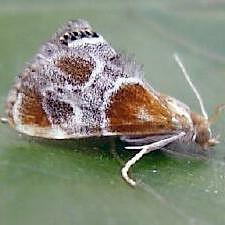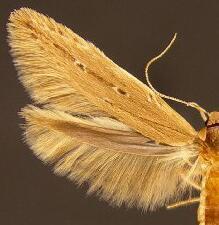Call for Photographs :

4896 -- Chalcoela pegasalis
Lady Lake, Florida
© Machele White
|
In the more than Two Months Since the last update another 700 photographs have been added to the Living Moths Plates Series, including 200 new species. The plates now hold about 1,750 species represented by 4,500 of your photos.
Moving to Mississippi: The Mississippi Entomological Museum at Mississippi State University has offered a permanent new home for MPG. It may take a few weeks before cosmetic changes are made throughout the website and the move is actually made to MSU web servers. The website will still look and feel pretty much the same except for some enhancements to make the site a bit more user friendly.
Over the next year the size of living moth plates will be reduced, with most of the content appearing on individual species pages. Link buttons will permit you to easily move back and forth between species pages, pinned specimen plates and living moth plates. After Google has had time to index the new website a search window will appear on all pages.
|
Recent Plate Additions :

1515 -- Limnaecia phragmitella
© Jim Vargo
|
Filling In The Blanks: Jim Vargo lives in Indiana, and collects moths with a passion (over 4,900 species so far). Jim has already contributed hundreds of photos of pinned specimens in his collection, many of which are for species never before seen on the Internet. Filling in blank spaces on the plates for eastern macros was his first priority, followed by doing the same for the western plate series.
New Micromoth Plates: Most exciting (to me, anyway) are Jim's photos of the micromoths, which so far grace two plates, with many hundreds of additional species yet to come. See Plate 01 for example.
Speaking of Plates: The long-awaited reissue of Charlie Covell's Field Guide to Moths of Eastern North America is now a reality, and the black-and-white plates are much improved over the 1984 edition. The new publisher is the Virginia Museum of Natural History. See the Books Page for ordering information. You will now also find information on the pages for Organizations and for Moth-related Websites.
|
May - July Donations :

8318 - Lymantria dispar (Gypsy Moth)
Nepean, ON - © Nolie Schneider
|
Welcome New Contributors: Kim Abel (WA), Lisa Ames (GA), Jane and John Balaban (IL), Greg Beaudoin (ON), Dean Blair (MD), Arlene Brazeau (ON), Richard Breen (WI), Steve Collins (FL), Donald Crosswaite (KY), Cliff Davis (VA), Bill DuPree (GA), George Detrio and Heather Price (FL), Amy Doares (SC), Ned Eisner (MA), John Foltz (FL), Joseph Garris (NJ), Ben Grubbs (NC), Pat Hallben-Abberton (PA), Kate Houston (WI), John Lee (ON), Paul McNelis (PA), Scott Nelson (FL), Randy Newman (NC), Linda and Peter Payzant (NS), Joe Pringle (NC), Dennis Profant (OH), Herschel Raney (AR), Debbie Roos (NC), Carroll Rudy (WI), Matt Sadowski (CA), Chris Schmidt (AB), Jeannie Shermerhorn (NB), Brian Scholtens (SC), Joanne Shuman (VA), Joanne Spix (FL), Scott Taylor (CO), Tom Trocine (FL), Jim Vargo (IN), Machele White (FL), Marie Winn (NY), Jai Wolfe (MA), Andy Wraithmell (FL)
Got the Mothing Bug? Add your photographs to the collaborative effort here at Moth Photographers Group and help build the photobase that helps everyone interested in moth identification. Are You a Moth Specialist? Add an entry in your CV by refereeing a family or subfamily here, and help build the accuracy of the photo library.
|
Unidentified Photo Pages :

Gelechiid ? -- Bowie, Maryland
© Robert Patterson
|
2005 Unidentified Pages, have been added for recent photographs. Rather than being organized by contributor the photos are grouped as Micros, Tortricids, Pyralids and Macros. This should permit specialists to more easily assist in identifying the moths. Brian Scholtens, at the College of Charleston (SC), has agreed to referee the Pyralidae beginning after Labor Day.
You don't have to wait until the end of the season to send in photos of your unidentified moths. Do it daily or weekly and you'll enjoy knowing what many of them are much sooner. You can also post photos of your unidentified moths at the interactive BugGuide.Net. An additional group of persons monitors the postings there. Most of the moth photos posted at BugGuide.Net are also picked up for use here. Please remember to post square photos so that they will meet the requirements of the MPG Plates.
Your Unidentified Moths: Send them in. Any number, 1 to 100 or more, just pick the best photo of each species that you can't identify. Once a photo has been identified it will move to the live moth archives where it can help others to identify their moths. See the Submit a Photo page.
|






